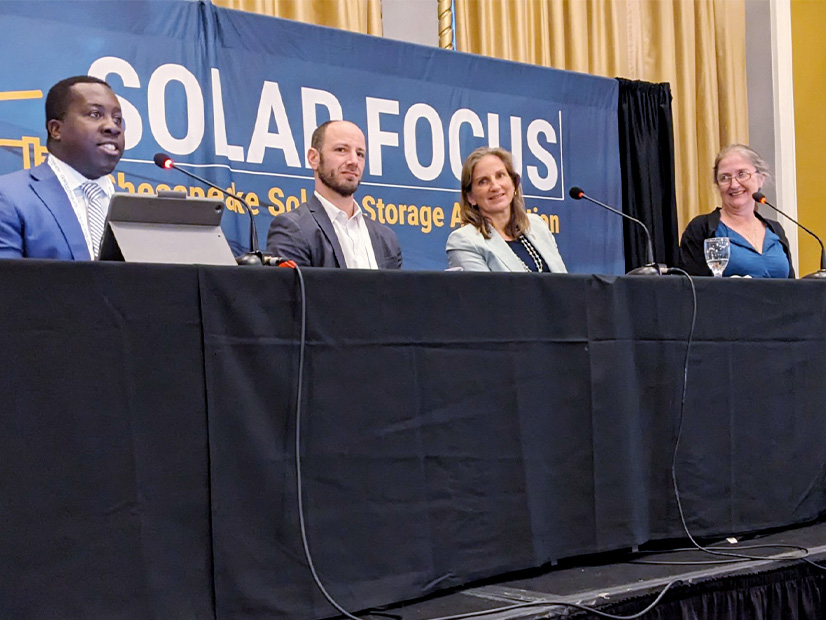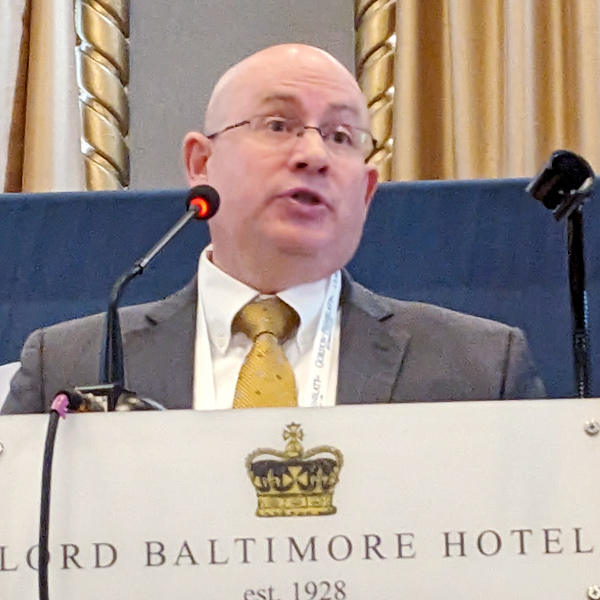
BALTIMORE, Md. ― Maryland officials like to point out the state now has the country’s most ambitious greenhouse gas emissions reduction goal — 60% by 2031 — and is also aiming for 100% clean power by 2035, with 14.5% coming from in-state solar.
Hitting those targets is doable, but hard, they say.
“It’s going to be incredibly complicated,” said Josh Tulkin, director of the Maryland Sierra Club, speaking at the Solar Focus conference sponsored by the Chesapeake Solar and Storage Association (CHESSA) on Nov. 16. “There’s a desire to often say because we have to do it, let’s also make it sound super easy. It won’t be super easy. We have 100 years of … using one particular system weighted toward a particular type of power generation.”
“There’s a lot of hard stuff we’ve got to face,” agreed Del. Lorig Charkoudian (D). “If we roll up our sleeves, we can do it, but it does mean we have to be willing to acknowledge the challenges along the way and be willing to be creative and be willing to sit down a lot of times with folks that we’re not usually sitting down with to sort through and find solutions together.”
As detailed in panel discussions at the conference, the obstacles to a decarbonized electric system include the siting and permitting problems many solar developers face, Maryland’s dependence on out-of-state wholesale power — still about 60% fossil fuels — and the need for grid modernization to interconnect the clean power coming online.
On the plus side are Maryland’s Democratic Gov. Wes Moore and Democratic control of both houses in the General Assembly, as well as a new Democratic majority on the state’s Public Service Commission.
But, Charkoudian cautioned, having political majorities may not translate into the policies or the market forces the state will need.
“Markets are … not real things in and of themselves,” she said. “They are things we created from policy; so, whatever we want the market to do, we can make the market do. So, if we’re saying the market’s not working, it’s our fault, our policy and results,”
The bigger question for Charkoudian is not if, but “how do we get [to 100%]? … How do we set up the market so there’s a regulatory framework that allows us to get there?”
Kristen Harbeson, political director of the Maryland League of Conservation Voters, said that incorporating environmental justice strategies into policymaking from the start will be critical and likely uncomfortable for many. Like Charkoudian, Harbeson called for expanding the stakeholder voices sitting at the tables where legislative and regulatory priorities are set and compromises forged.
“Even if your table is full … figure out who’s not at the table, who needs to be at the table, making sure any community that your project or your effort touches is being engaged,” she said.
“If you’re comfortable, you’re probably not doing it right,” Harbeson said. “You need to be ready to be uncomfortable because progress happens in the space between discomfort and sheer panic.”
Community Solar
Maryland’s Climate Solutions Now Act (CSNA), passed in 2022, set the 60% emissions reduction goal. As mandated in the law, the Department of the Environment will roll out its implementation plan before the end of the year. Speaking at a conference in October, Environment Secretary Serena McIlwain hinted the plan would focus on transportation, buildings and exploring options for expanding renewable energy. (See Chasing Goals, Facing Obstacles at Md. Clean Energy Summit.)
In Maryland, policymakers and project developers appear to be focusing on in-state initiatives, aimed at growing the local solar market, as they wait for PJM to clear its backlog of utility-scale solar and storage projects, which could take until 2026, (See Solar Developers Sing Mid-Atlantic Interconnection Blues.)
The state imports about 40% of its power through PJM, according to the U.S. Energy Information Administration.
Maryland is behind on its efforts to reach the 14.5% solar target, according to former state Sen. Paul Pinsky, sponsor of the CSNA and now director of the Maryland Energy Administration. The passage of H.B. 908 in April, making Maryland’s community solar pilot program permanent, could help the state make up lost ground, he said, speaking at the two-day Solar Focus conference on Nov. 15.
Del. Luke Clippinger (D), a sponsor of H.B. 908, sees the law as a first step. Making the program permanent has raised public interest in community solar, which could in turn lead to “creative opportunities for businesses and nonprofits to come together and work with individual neighborhoods and work with individual communities so that we can expand this program, especially in low- and moderate-income communities across the state,” Clippinger said.
The law requires that 40% of the output of community solar projects in the state goes to low- and moderate-income subscribers.
“The greatest potential for expanding the growth in renewable energy is in our low- and moderate-income population because they don’t generally have the ability to do this otherwise,” he said.
V2G, VPPs and TOU
Looking toward the 2024 legislative session beginning in January, Del. David Fraser-Hidalgo (D) is working on a new bill to promote the development of residential solar and storage, electric vehicle-to-grid (V2G) systems and virtual power plants (VPPs).
The Distributed Renewable Integration and Vehicle Electrification (DRIVE) Act will “encourage the PSC to craft incentives and reduce barriers for consumers hoping to participate in V2G charging and those who wish to participate in a VPP,” Fraser-Hidalgo said in an email to RTO Insider.
The PSC will also be authorized “to identify the most cost-effective way to roll out VPPs in coordination with FERC, PJM and other stakeholders” and to explore the introduction of default time-of-use rates at a future, not-yet-determined date, he said.
With V2G, an electric vehicle’s battery can be tapped to put power on the grid at a time of emergency or high demand. Similarly, VPPs are combinations of distributed energy resources — such as solar and storage — that either can connect to the grid when needed or operate off-grid in emergencies to keep the power on at community centers, hospitals or other critical facilities.
Time-of-use rates provide price signals to consumers to manage their energy use by charging increased rates during times of peak demand and lower rates in off-peak hours.
Previewing the bill at Solar Focus, Fraser-Hidalgo said the DRIVE Act would use a term like “discounted rates” rather than time-of-use. “I think everybody [at the conference] probably knows what time-of-use is … but when you’re trying to get people to change behavior, probably something like discounted rates makes a lot more sense.”
The bill aims to address questions about “how do we work with utilities and how do we diversify where we get electricity from, how we store electricity and how we distribute electricity,” he said, while also creating “a lot of resilience and redundancy we currently do not have.”
Charkoudian agrees that distributed resources, like V2G and VPPs, will be “a huge piece” of Maryland’s march to 100% clean energy, but she cautions that policy, regulation, technology and markets have to be aligned. “Storage is a perfect example of the mismatch,” she said.
“Precisely because storage can do so much … it’s not just generation and it’s not just ancillary services; it’s not just a balancing of load; but [because] it’s all those things … none of the markets really work for it,” she said.
“We’ve got to find a way to get the conversation happening in a way that allows us to really head in the right direction or else we could have all the technology, all the brilliant people and not get our policies right and miss the opportunity,” she said.



